Tonight, you’ll spot Uranus in Taurus as a tiny blue-green disk with magnitude 5.83. Look southwest between 7:36-10:54 PM when it reaches 47.76° altitude. You can track its motion against background stars, observe its unique color from methane absorption, and potentially glimpse its largest moons Titania and Oberon with good equipment. With patience, you might detect brightness variations, the extreme 98° axial tilt, and even photograph this ice giant using a 4-inch telescope.
10 Key Uranus Features You Can See Tonight
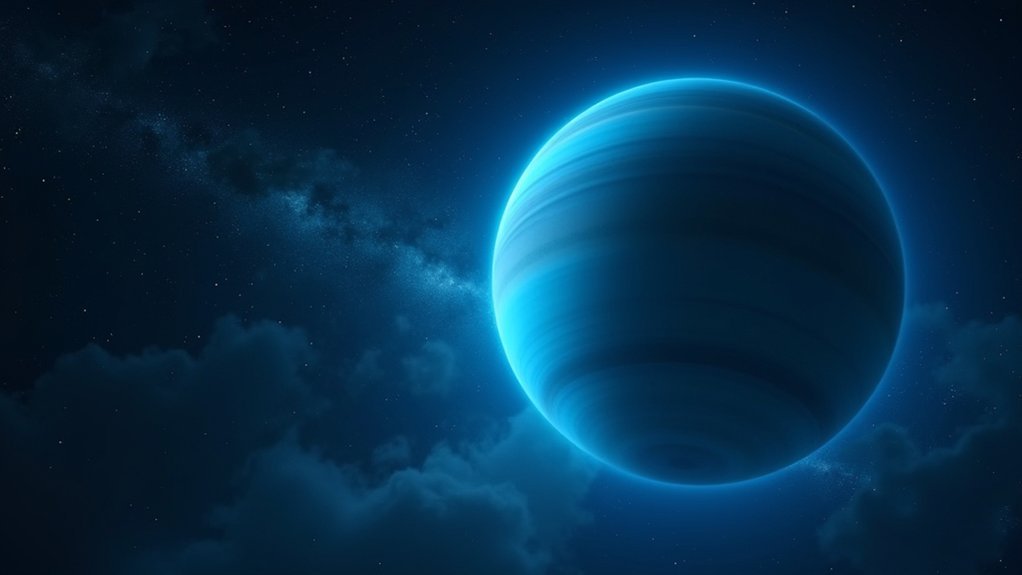
When scanning the night sky for Uranus tonight, you’ll find it nestled in Taurus at a brightness magnitude of 5.83.
This elusive ice giant is positioned at right ascension 03h 31m 45s and declination +18° 51′ 17″, making it challenging but possible to spot with the naked eye under dark skies.
For the best view, look toward the south-west at an azimuth of 232.30° where Uranus reaches an impressive altitude of 47.76° above the horizon.
You can observe it from its rise at 7:36 PM until it sets at 10:54 PM in Greenwich.
Small binoculars will easily reveal Uranus as a tiny, pale blue-green disk in Taurus.
Use an interactive sky map to pinpoint its exact location among the stars.
The Distinctive Blue-Green Disk
Methane’s unique light-absorbing properties create Uranus’s signature blue-green appearance that stands out distinctly among celestial objects. You’ll find this fascinating planet currently positioned in Taurus at an altitude of 47.76 degrees, making tonight an excellent viewing opportunity before it sets at 22:54 local time in Greenwich.
| Viewing Aspect | Your Experience |
|---|---|
| Color | Mesmerizing blue-green hue unlike any other planet |
| Visibility | Barely naked-eye visible (5.83 magnitude) |
| Equipment | Small binoculars transform viewing dramatically |
| Location | Southwestern sky (232.30° azimuth) |
| Timing | Best after sunset until ~22:54 |
With binoculars, you’ll easily distinguish Uranus’s distinctive disk shape. Its composition of water, methane, and ammonia absorbs red light while reflecting blue-green wavelengths, creating that enthralling otherworldly appearance you won’t forget.
Spotting Uranus’s Axial Tilt
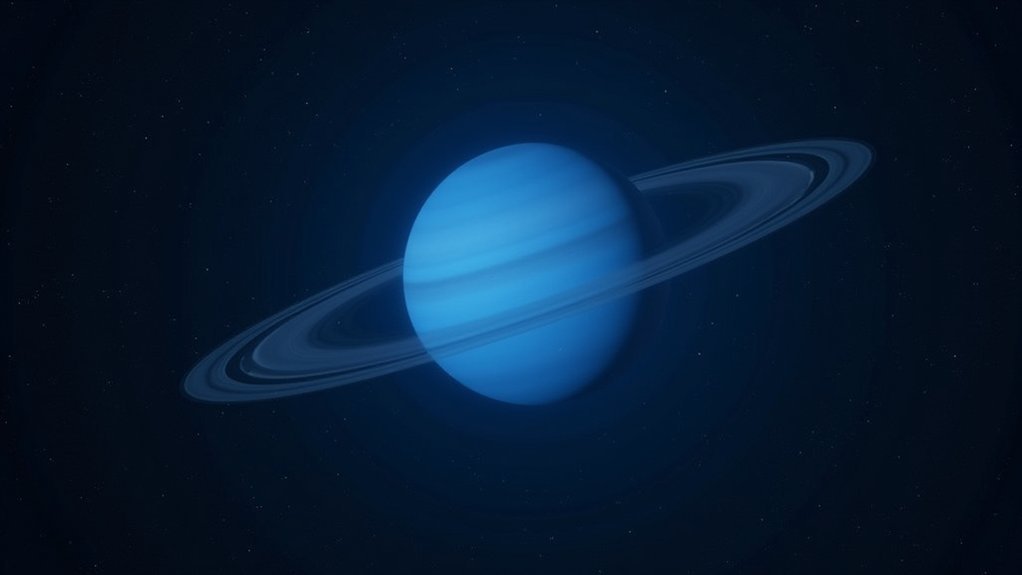
You’ll notice Uranus’s extreme 98-degree tilt when observing tonight, as the planet fundamentally rotates on its side compared to other planets.
Position your telescope at the correct angle to better perceive the rings’ orientation, which appear nearly perpendicular to the ecliptic plane.
With steady viewing conditions, you can distinguish this unique axial tilt that creates 42-year-long seasons at the poles and dramatically affects how the planet’s features appear from Earth.
Sideways Rotation Visibility
How often do you get to observe a planet that fundamentally rolls around the Sun? Uranus offers precisely this rare sight as it travels through Taurus this season.
With its extraordinary 98-degree axial tilt, you’re witnessing a planet that rotates on its side relative to its orbital plane.
On a clear night, aim your binoculars or telescope toward Taurus to spot this sideways-spinning world. The planet completes a full rotation in just 17.2 hours, though you won’t detect this motion in a single viewing.
What you can appreciate is the unique orientation that causes one pole to face the Sun for 42 Earth years while the other remains in darkness.
At certain times, you’ll even catch a glimpse of Uranus’s rings appearing edge-on from our vantage point.
Telescope Angle Techniques
Three key angles will help you successfully observe Uranus’s remarkable tilt tonight. To spot the planet’s unique 98-degree axial tilt, position your telescope at 47.76 degrees altitude and 232.30 degrees azimuth (South-West). The planet’s current right ascension of 03h 31m 45s places it in Taurus, making it easier to locate with celestial coordinates.
For ideal visibility:
- Aim for transit time at 15:15 local time when Uranus reaches its highest point
- Adjust your telescope’s focus gradually at the precise altitude
- Use the azimuth setting to track the planet as Earth rotates
- Remember its 5.83 magnitude requires a telescope for clear observation
With proper telescope positioning, you’ll witness firsthand how Uranus’s poles directly face the Sun—a truly unique sight in our solar system.
Tracking Uranus’s Motion Against Background Stars
You’ll find Uranus easier to track by using binoculars to establish a visual pattern with nearby bright stars in Taurus, noting its position over several nights to observe its subtle movement.
Start with the prominent stars of the constellation and work your way toward Uranus’s current coordinates (RA: 03h 31m 45s, Dec: +18° 51′ 17″) through a technique called “constellation hopping.”
For the clearest view of Uranus’s movement, choose reference stars that won’t shift position and observe during the ideal window between its 7:36 PM rise and 10:54 PM set time.
Binocular Tracking Techniques
Although Uranus appears nearly stationary during a single viewing session, tracking its subtle motion against background stars reveals its planetary nature.
You’ll find Uranus in Taurus at right ascension 03h 31m 45s and declination +18° 51′ 17″. For ideal visibility, observe around its 15:15 transit time when it reaches 47.76 degrees altitude.
- Use binoculars with at least 7x magnification to make Uranus’s 5.83 magnitude more discernible
- Start your observation after it rises at 7:36, continuing until it sets at 22:54
- Create a simple star chart marking Uranus’s position relative to nearby fixed stars
- Return to the same viewing spot over consecutive nights to detect its gradual movement within the constellation
Constellation Hopping Methods
Tracking Uranus night after night is made simpler through constellation hopping, a technique that uses recognizable star patterns as navigational stepping stones. Start by locating Aldebaran, the bright orange star in Taurus, then use the coordinates (RA: 03h 31m 45s, Dec: +18° 51′ 17″) to pinpoint Uranus’s exact position.
| Hopping Step | Technique | Time | Visibility |
|---|---|---|---|
| Locate Taurus | Find V-shaped Hyades | Dusk | Easy |
| Find Aldebaran | Bright orange star | 19:00 | Very bright |
| Measure 47.76° | Use altitude setting | Before 22:54 | best angle |
| Spot Uranus | Use binoculars | Dark skies | Magnitude 5.83 |
Remember that while Uranus in Taurus is technically visible to naked eye under perfect observing conditions, your star map’s automatic orientation feature will greatly improve your chances of success.
Observing Uranus’s Brightness Variations
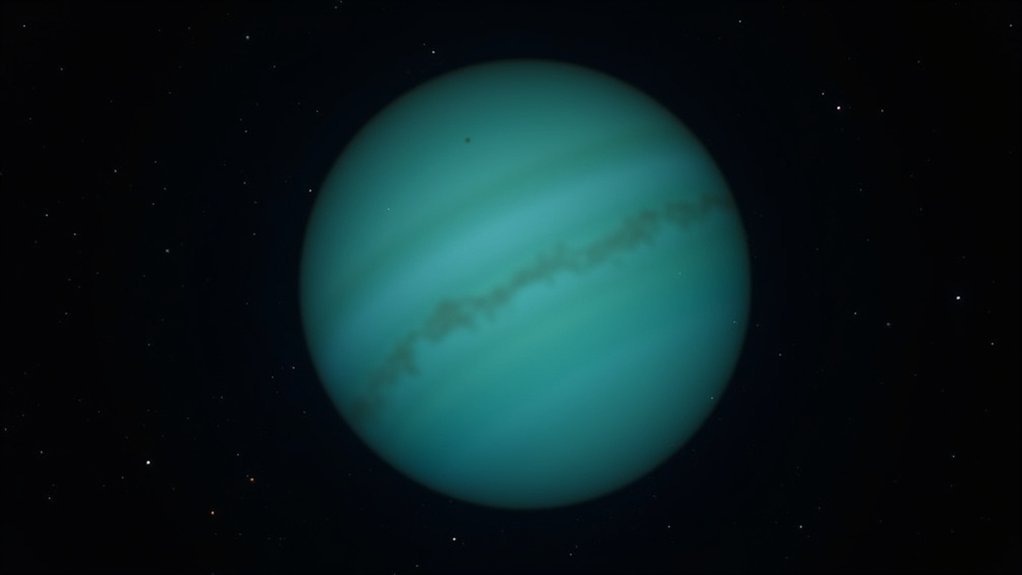
While most planets display obvious brightness changes throughout their orbital period, Uranus offers a more subtle viewing experience with its current magnitude of 5.83. This makes the planet just barely visible to the naked eye under ideal conditions, but you’ll find it’s easily observable with even small binoculars.
To track Uranus’s brightness variations effectively:
- Use interactive sky maps to pinpoint its current position
- Account for the 2 hour, 49 minute light travel time when observing
- Compare real-time light curve predictions with your observations
- Document your viewing conditions for accurate brightness assessment
Remember that although the changes in Uranus’s brightness are less dramatic than other planets, tracking these subtle variations adds depth to your observing experience and helps you develop more refined astronomical skills.
Detecting Uranus’s Atmospheric Bands
The ethereal atmospheric bands of Uranus present one of the most challenging yet rewarding targets for amateur astronomers. When observing the planet in Taurus tonight, you’ll need patience and ideal viewing conditions to detect these elusive features.
Uranus’s blue-green appearance comes from its unique atmosphere of water, methane, and ammonia. The visibility of its atmospheric bands improves when the planet reaches its brightest magnitude of 5.83.
The methane-rich atmosphere gives Uranus its distinctive hue, with band visibility peaking at maximum brightness.
Position your telescope when Uranus is at its highest altitude of 47.76 degrees for the best chance of success.
The planet’s extreme 98-degree axial tilt creates seasonal variations that affect band prominence. With temperatures plunging to -224°C, dynamic weather patterns can make these bands more pronounced during certain periods of its 84-year orbit.
Glimpsing Uranus’s Largest Moons
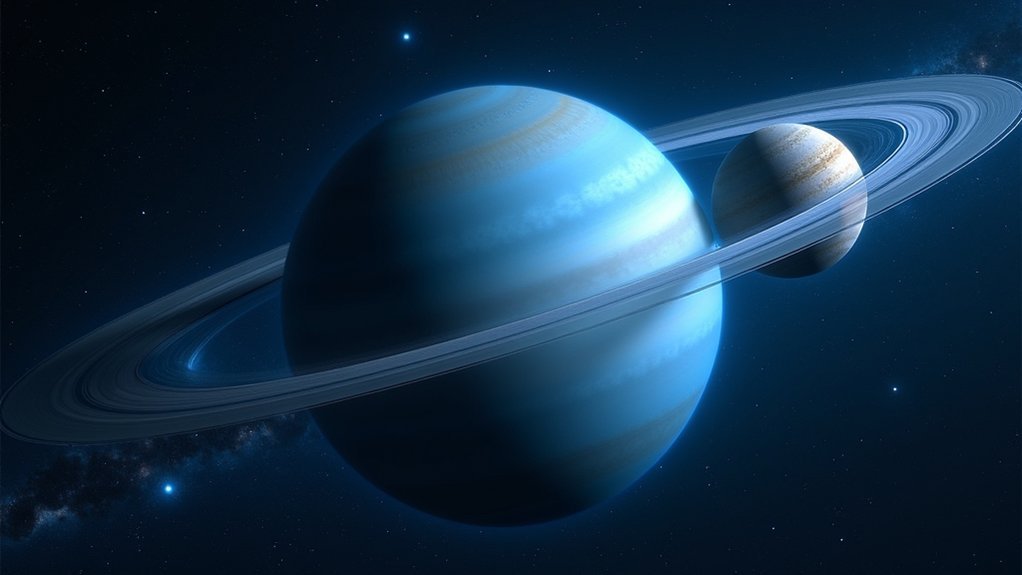
You’ll need a telescope with at least 8-inch aperture to spot Titania, Uranus’s largest moon, which appears as a tiny dot near the planet’s cyan disk.
Oberon’s faint glow can be distinguished with patience and averted vision techniques on exceptionally clear nights when Uranus is at opposition.
If you’re extremely lucky with timing and equipment, you might glimpse Ariel’s shadow as it transits across Uranus’s cloud tops, appearing as a tiny dark spot against the planet’s surface.
Titania Viewing Tips
Spotting Titania, Uranus’s largest moon, requires patience and the right equipment during tonight’s observation. At 1,578 kilometers in diameter, this eighth-largest moon in our solar system orbits Uranus at 436,300 kilometers, completing one revolution every 8.7 days.
With Uranus currently at magnitude 5.83, Titania’s visibility depends on optical aid and viewing conditions.
For best results:
- Use at least a 6-inch telescope with 150x magnification to separate Titania from Uranus’s glare.
- Wait for Titania to reach its maximum apparent distance from the planet (about 12 arcseconds).
- Observe during times of excellent atmospheric stability when the air is still.
- Try the averted vision technique—looking slightly to the side of Uranus to better detect Titania’s faint light.
Oberon’s Faint Glow
While Titania may steal the spotlight as Uranus’s largest moon, Oberon offers a subtler celestial challenge for tonight’s observers. At 1,523 kilometers in diameter, Oberon’s faint glow comes from its low albedo—reflecting only 24% of incident sunlight.
You’ll need small binoculars to catch this elusive moon, as its magnitude of 14.1 sits just beyond naked-eye visibility, even under excellent dark sky conditions.
| Feature | Specification | Visibility Tip |
|---|---|---|
| Diameter | 1,523 km | Use 10×50 binoculars |
| Orbital Distance | 582,600 km | Look 13 arcminutes from Uranus |
| Orbital Period | 13.5 Earth days | Track over multiple nights |
| Albedo | 24% | Requires dark sky location |
The heavily cratered surface reveals Oberon’s ancient history, while its 13.5-day orbit means you’ll notice its position shift if you observe over consecutive nights.
Spotting Ariel’s Shadow
Five of Uranus’s largest moons can be viewed tonight, with Ariel offering one of the most fascinating phenomena. This 1,158-kilometer ice-covered moon casts a visible shadow on Uranus’s surface during specific alignments—a rare treat for patient observers.
To maximize your chances of spotting Ariel’s shadow:
- Aim your telescope at Uranus around 15:15 local time in Greenwich when the planet reaches its highest point.
- Look for a faint dot approximately 191,000 kilometers from Uranus—that’s Ariel.
- Watch for the tiny dark spot moving across Uranus’s disk—this is Ariel’s shadow.
- Use medium to high magnification to improve shadow visibility.
Ariel completes an orbit every 2.5 Earth days, so timing is essential for catching this elusive shadow play against the planet’s pale blue-green surface.
Viewing Uranus’s Faint Ring System
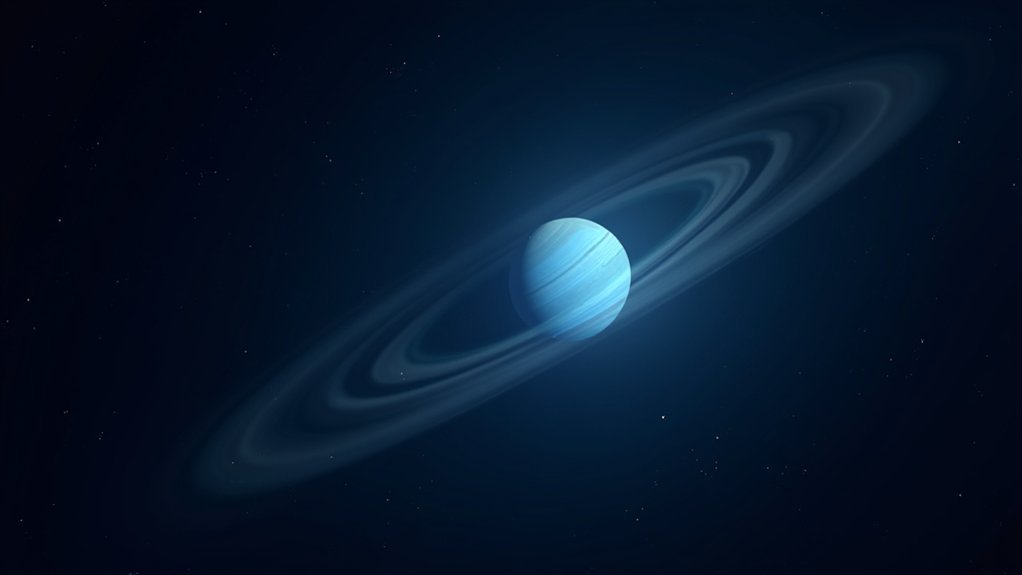
Although Uranus’s rings don’t share the fame of Saturn’s magnificent bands, they represent one of the solar system’s most challenging and rewarding telescopic targets. Discovered in 1977, this faint ring system was only the second planetary ring structure ever identified.
When you’re observing Uranus tonight, you’ll need a powerful telescope to glimpse these elusive features. The 13 known rings primarily consist of ice particles mixed with dark carbon materials, giving them low reflectivity. The epsilon ring stands out as the brightest and most well-defined in the system.
Unlike Saturn’s expansive rings, Uranus’s rings hug close to the planet, with the outermost ring just 63,000 kilometers from the planet’s center.
At magnitude 5.83, Uranus itself is barely visible to the naked eye in ideal conditions.
Comparing Uranus’s Size to Other Planets
When comparing celestial bodies in our solar system, Uranus stands as a true giant, holding its place as the third-largest planet with an impressive diameter of 50,724 kilometers.
This ice giant‘s massive scale becomes apparent when you consider it could contain about 63 Earths by volume, with a mass 14.5 times greater than our home planet.
Unlike the gas giants Jupiter and Saturn, Uranus’s composition of water, methane, and ammonia earns it the ice giant classification.
Uranus stands apart from gas giants with its distinctive icy makeup of water, methane, and ammonia.
To appreciate this giant planet’s place in our solar system:
- Uranus ranks 3rd in size after Jupiter and Saturn
- Its mass is 8.68 x 10^25 kg (14.5 Earth masses)
- Its unique 98-degree axial tilt causes extreme seasons
- Its volume can contain approximately 63 Earths
Photographing Uranus With Amateur Equipment
While Uranus’s massive size makes it an impressive object in our solar system, capturing this distant ice giant through your camera requires specific techniques and equipment.
You’ll need a telescope with at least a 4-inch aperture to enhance Uranus’s visibility and reveal its distinctive bluish color—a result of its methane-rich atmosphere. For photography, attach your smartphone to your telescope using an adapter, ensuring everything is properly stabilized for clearer images.
Uranus’s small apparent size makes stability vital for quality results. Plan your photography session between 7:36 PM when Uranus rises and before it sets at 10:54 PM. You’ll find the planet in Taurus at RA 03h 31m 45s and Dec +18° 51′ 17″.
While visible to the naked eye at magnitude 5.83 under perfect conditions, a telescope will dramatically improve your photograph’s detail.
Frequently Asked Questions
How to Identify Uranus in the Night Sky?
You’ll find Uranus in Taurus with binoculars by looking southwest, about 48 degrees above the horizon. Use its coordinates (RA: 03h 31m 45s, Dec: +18° 51′ 17″) or an online sky map for precise location.
What Does Uranus Look Like at Night?
Through a telescope, you’ll see Uranus as a small blue-green disk. With binoculars or naked eye, it appears as a dim star-like point that doesn’t twinkle, unlike actual stars around it.
What Are the Key Attractions of Uranus?
Uranus’s key attractions include its unusual sideways rotation, blue-green color from methane, 27 moons, and faint rings. You’ll need binoculars to appreciate its disk-like appearance since it’s barely visible to naked eyes.
Are There Any Special Features on Uranus?
Yes, Uranus features its unique sideways rotation, distinctive blue-green color from methane, a faint ring system with 13 rings, and extreme seasonal variations due to its unusual axial tilt you can observe tonight.
In Summary
You’ve now got all you need to observe Uranus tonight! With its unique blue-green disk, extreme tilt, and fascinating moons, you’ll find this ice giant is much more than just a distant point of light. Don’t be discouraged if you can’t see everything on your first try—each viewing session will improve your skills and reveal new details of this mysterious world.




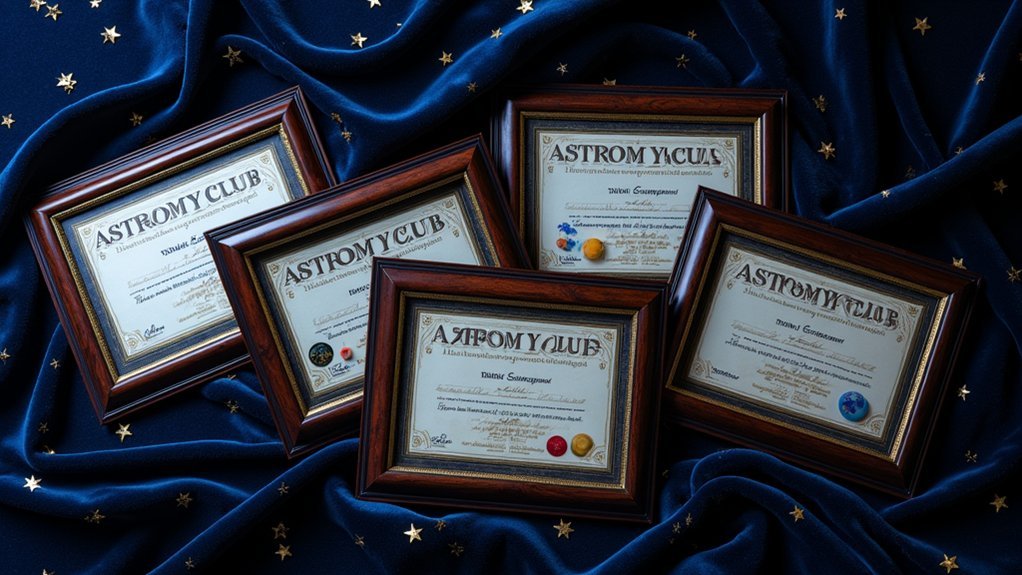
Leave a Reply